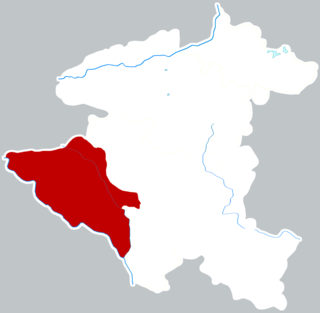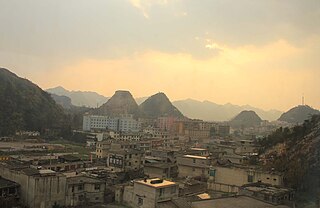
Qingzhen is a county-level city under the administration of Guiyang, the capital of Guizhou Province, China. It is located to the west of Guiyang's urban core, bordering Huaxi District to the southeast, the districts of Guanshanhu and Baiyun to the east and Xiuwen County to the northeast.

Yushu is a county-level city of Jilin Province, Northeast China, it is under the administration of the prefecture-level city of Changchun. It is more than 140 kilometres (87 mi) to the northeast of central Changchun, and around 100 kilometres (62 mi) south of Harbin. The name of the place means "Elm Tree". The northernmost county-level division of Changchun, it borders Dehui to the southwest as well as the prefecture-level division of Harbin (Heilongjiang) to the northeast.
Longjing is a county-level city in the Yanbian Korean Autonomous Prefecture, south-eastern Jilin province, China. It lies on the Tumen River, opposite the North Korean city Hoeryong. Longjing is "the birthplace of Chinese Korean folk culture, the area in China where Korean people live most concentratedly and where Korean folk culture is best preserved."

Meihekou is a city of 600,000 in Jilin, People's Republic of China. It is a regional transport hub, connecting three railway lines, all of which are single track, and two national highways. The city is also a major lorry transshipment point in the region as it is also the junction of two trunk roads, connected to Liaoyuan in the northwest. The city is administratively a county-level city of the prefecture-level city of Tonghua, and is its northernmost county-level division.

Huanren Manchu Autonomous County, formerly Huairen County, is a county under the administration of Benxi City, in eastern Liaoning province, China, bordering Jilin to the east. It is also one of 11 Manchu autonomous counties and one of 117 autonomous counties nationally. As a county, Huanren was established in 1877. It was reorganised as an autonomous county in 1989 with approval of the State Council. The county covers 3,362 square kilometres (1,298 sq mi) and has 293,505 population, and Huanren Town is its seat.

Shiqian County is a county under the administration of the prefecture-level city of Tongren, in the northeast of Guizhou Province, China. The government is located in Tangshan.

Jiangkou County is a county under the jurisdiction of the prefecture-level city of Tongren, in the northeast of Guizhou Province, China. The county government is located in Shuangjiang.
Wanshan District is a district of the city of Tongren, Guizhou province, China, bordering Hunan province to the southeast and east. Wanshan was known as Wanshan Special District (万山特区) until November 2011, when it was renamed Wanshan District. The district has an area of 338 square kilometres (131 sq mi) and in 2002 had a population of 60,000.

Peng'an County is a county in Nanchong, Sichuan, China.

Xiapu is a county in the municipal region of Ningde, Fujian, People's Republic of China, located along a stretch of East China Sea coast, with many harbours and islands. It is bordered by Fuding City and Zherong County to the north, Fu'an City and Ningde's urban area to the west, and Luoyuan County, Fuzhou and the Matsu Islands of Lienchiang County, Republic of China (Taiwan) to the south.

Ninglang Yi Autonomous County is located in the northwest of Yunnan province, China, bordering Sichuan province to the northeast. It is under the administration of Lijiang City. The county is home to the Mosuo people, who lived under the quasi-independent Chiefdom of Yongning until abolished in 1956. Ninglang Luguhu Airport is located in the county.

Guanling Buyei and Miao Autonomous County is an autonomous county in Anshun City, in the southwest of Guizhou Province, China.

Pengxi County is a county of Sichuan Province, China, bordering Chongqing to the southeast. It is under the administration of Suining city.

Shimian County is both the southernmost and westernmost county in the prefecture-level city of Ya'an, Sichuan Province, China. The county seat, Miancheng Subdistrict (棉城街道), and the neighboring town, Xinmian (新棉镇), are often together referred to as Shimian. As of the 2010 census, Shimian County has a population of 123,600. The G5 Beijing–Kunming Expressway now passes through Shimian along the route between Kunming and Chengdu.
Pingnan is a county in the east of Guangxi, China. It is both the easternmost and northernmost county-level division of the prefecture-level city of Guigang, with a population of 520,000 residing in an area of 2,989 km2 (1,154 sq mi).

Liuzhi Special District is a district of Guizhou, China. It was known as Langdai Country before 1960. The county is under the administration of Liupanshui city, located in the western part of Guizhou Province. It is bounded by Zhijing and Nayong to the north, Guanling to the south, Zhenning and Puding to the east, Shuichen to the west, as well as Qinglong and Pu'an to the southwest. The area is approximately 1,792 km2 (692 sq mi). The population is 729,000. There are about 32 ethnic minorities and they account for 30.52% of the population.
Zheng'an County is a county in the north of Guizhou province, China, bordering Chongqing to the north. It is under the administration of the prefecture-level city of Zunyi.

Weining Yi, Hui and Miao Autonomous County is a county of Guizhou, China. It is under the administration of the prefecture-level city of Bijie.

Huinan County is a county of southwestern Jilin province, China. It is under the administration of Tonghua City, with a population of 350,000 residing in an area of 2,277 km2 (879 sq mi).
Antu County is a county of southeastern Jilin province, Northeast China. It is under the administration of the Yanbian Korean Autonomous Prefecture. Antu is home to Korean and Manchu minorities. In 2020 it had a population of 195,000, of which 17.9% Koreans. It has a border crossing with North Korea at Shuangmufeng (双目峰).


![Boli (labelled as P'o-li [sic] Bo Li
) (1955) Txu-oclc-6614368-nl52-9.jpg](http://upload.wikimedia.org/wikipedia/commons/thumb/0/0c/Txu-oclc-6614368-nl52-9.jpg/220px-Txu-oclc-6614368-nl52-9.jpg)














